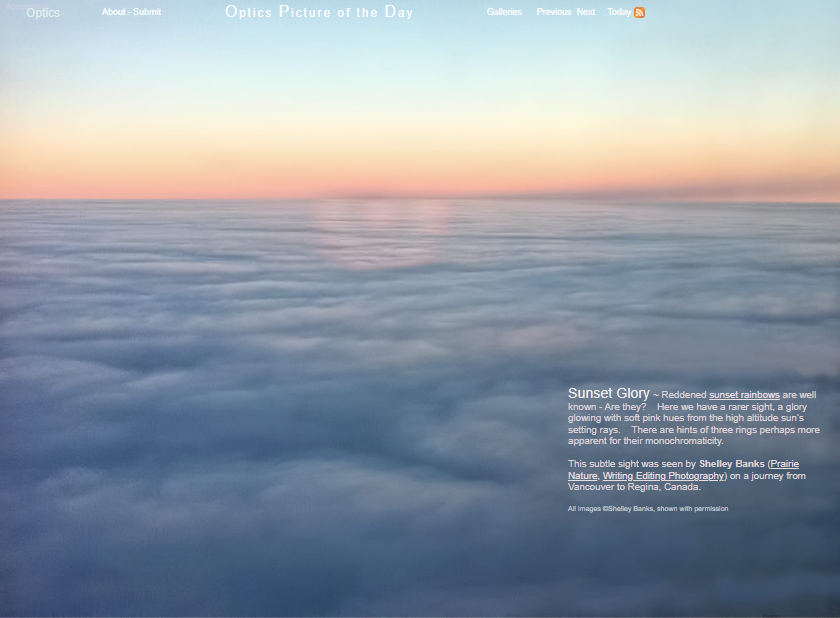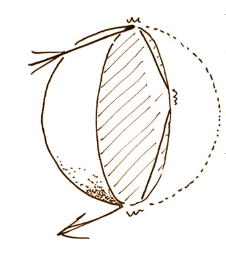Glory at Sunset - OPOD
Glory at Sunset - Exploring a Rare Atmospheric Phenomenon
Have you ever witnessed a reddened sunset rainbow? While they may be relatively well known, there is another captivating sight that is even rarer - a glory glowing with soft pink hues from the high altitude sun's setting rays. Recently, Shelley Banks, an avid nature enthusiast and talented photographer, had the opportunity to capture this subtle yet mesmerizing spectacle during her journey from Vancouver to Regina, Canada.
Glories, like rainbows, appear directly opposite the sun. They are formed through a diffraction pattern caused by the scattering of light by small cloud droplets, typically ranging in diameter from 1 to 50 microns. While the classical ray-path description of a glory may seem inadequate or even impossible, it is essential to understand the behavior of light waves constricted within tiny spherical cavities.
To shed light on this phenomenon, Dutch physicist and Nobel laureate Peter Debye developed a light scattering formulation known as Debye theory. Unlike Mie theory, Debye theory provides valuable insights into the mechanism of light scattering in droplets. According to Debye's formulation, the central illumination of a glory primarily originates from light reflected once inside the droplets. However, there are also lesser contributions from light reflected 10, 6, and 5 times, as well as the influence of surface waves.
When observing a glory at sunset, it is fascinating to note the pinkish hues that infuse the rings. This unique coloration is a result of the sun's setting rays passing through Earth's atmosphere at a low angle. As sunlight traverses a longer path through the atmosphere during sunset, shorter wavelengths (such as blue and green) are scattered more, while longer wavelengths (such as red and pink) remain relatively unaffected. This scattering phenomenon is responsible for the enchanting pink glow of a sunset glory.
Apart from its distinctive appearance during sunset, a glory can also be observed under different atmospheric conditions. Shelley Banks had the opportunity to capture another glimpse of a more typical glory while flying in a prop plane east of Calgary. The circular rings of the glory were clearly visible against the backdrop of the sky, creating a truly awe-inspiring sight.
In conclusion, witnessing a glory at sunset is an extraordinary experience that showcases the beauty and complexity of atmospheric optics. As we delve into the science behind this phenomenon, we gain a deeper understanding of the intricate interplay between light, cloud droplets, and the atmosphere. Next time you find yourself admiring a captivating sunset, keep an eye out for the elusive glory, and appreciate the wonders that nature has to offer.

Sunset Glory ~ Reddened sunset rainbows are well known - Are they? Here we have a rarer sight, a glory glowing with soft pink hues from the high altitude sun’s setting rays. There are hints of three rings perhaps more apparent for their monochromaticity.
This subtle sight was seen by Shelley Banks (Prairie Nature, Writing Editing Photography) on a journey from Vancouver to Regina, Canada.
All images ©Shelley Banks, shown with permission

Glories are directly opposite the sun, a diffraction pattern from scattering by small (1-50 micron diameter) cloud droplets.
The classical ray-path description at left is inadequate, indeed impossible. A water drop cannot send rays directly backwards.
Our macroscopic experience does not encompass the behaviour of light waves constricted in a tiny spherical cavity but our mathematics does. Dutch physicist/chemist and Nobel prize winner Peter Debye developed a light scattering formulation that, unlike Mie theory, provides some information on the mechanism of light scattering in droplets.
Debye theory shows that the major source of the glory's central illumination is light reflected once inside droplets. There are lesser contributions from light reflected 10, 6 and 5 times. Surface waves also play a role.

The more usual appearance of a glory pictured again by Shelley Banks from a prop plane east of Calgary

Note: this article has been automatically converted from the old site and may not appear as intended. You can find the original article here.
Reference Atmospheric Optics
If you use any of the definitions, information, or data presented on Atmospheric Optics, please copy the link or reference below to properly credit us as the reference source. Thank you!
-
<a href="https://atoptics.co.uk/blog/glory-at-sunset-opod/">Glory at Sunset - OPOD</a>
-
"Glory at Sunset - OPOD". Atmospheric Optics. Accessed on November 15, 2024. https://atoptics.co.uk/blog/glory-at-sunset-opod/.
-
"Glory at Sunset - OPOD". Atmospheric Optics, https://atoptics.co.uk/blog/glory-at-sunset-opod/. Accessed 15 November, 2024
-
Glory at Sunset - OPOD. Atmospheric Optics. Retrieved from https://atoptics.co.uk/blog/glory-at-sunset-opod/.